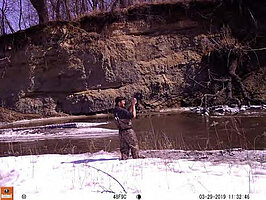Interdisciplinary approach to understanding fluvial geomorphology of post-glaciolacustrine meandering rivers: a case study of the Red River

Zachary Phillips is a PhD Student in the Environmental Conservation Science (ECS), Geoscience Department at North Dakota University. B.S. Geological Sciences (Ohio State University, 2012), M.S. Geoenvironmental Studies (Shippensburg University, 2016)
Interdisciplinary approach to understanding fluvial geomorphology of post-glaciolacustrine meandering rivers: a case study of the Red River
Research Abstract
The Red River of the North is a post-glaciolacustrine fluvial landscape impacted by Glacial Isostatic Adjustments (GIAs) that have influenced the spatiotemporal pattern of erosion and valley development on the Red River. Modern GIA is complex in the area of the Red River, with a combination of forebulge collapse and rebound acting to decrease Red River valley-slope by 4.1 x 10-6 vertical meters per horizontal kilometer per year. Such impacts cause erosional instabilities in some reaches of the Red River and cause floods to span greater widths and last longer. Although floods cause the greatest planform changes in meandering channels, the fluvial geomorphology is likely significantly influenced by the floodplain alluvium, hydrology, and GIA. The proposed research will apply (a) GIS mapping and analysis methods to determine the current erosional state of the Red River, (b) combined laboratory and numerical Landscape Evolution Modeling to constrain the dates of major channel avulsions of Red River Basin rivers, and (c) conduct field sampling of alluvial sediments to determine both the process of short term erosion during the spring thaw and the possible control of alluvium grain size distribution and composition on channel planform and meandering dynamics. Understanding the fluvial geomorphology of the Red River is important for the inhabitants of the land because of the persistent threat of floods, and because it is unique among rivers due to its excessively low slope, high sinuosity, geological infancy, and its rare existence atop a massive former lake bottom.
Research Highlights
This project contributed to developing the geomorphic history of the Red River Basin. There are several reasons that this basin provides an ideal case study for understanding river evolution and response to post glacial isostatic rebound, but perhaps the most significant are the well documented timing of river initiation and the presence of high-resolution topographic data for the entire basin. Taking advantage of these factors, we have made two significant findings related to river evolution. The first finding is related to the impacts of subsurface geology on river erosion. In the case of the Red River, buried glacial moraines have a clear impact on river erosion, driving more movement in close proximity to these features despite having little to know surface expression. The second finding is related to river avulsion, finding not only that isostatic rebound can be a driving force in avulsions, but that these happen early in the river evolution history. Beyond these two findings, this research also contributed new tools that can be used for geomorphic observations on rivers around the world. This project also examined processes on the modern Red River, specifically looking into the effects of river ice on erosion. Through both field and laboratory analyses it was found that in the rivers with higher sinuosity river ice impacts can be expected to occur more often and may contribute to bank erosion on the outside of meander bends.

Stephanie Day
Geosciences
Office: Stevens 228
Telephone: 701-231-8837
Email: stephanie.day@ndsu.edu


